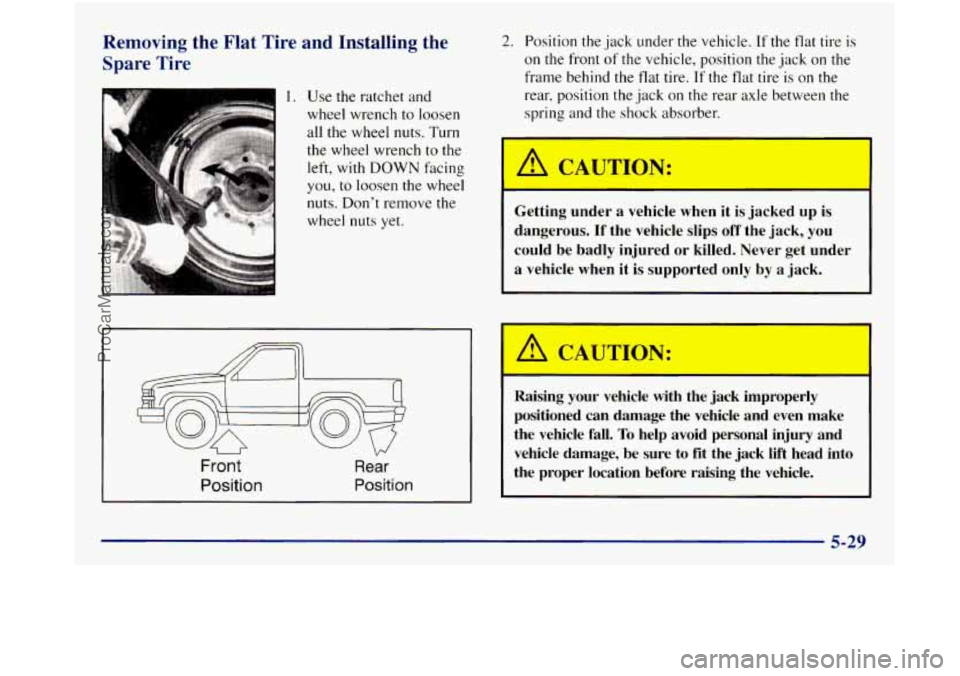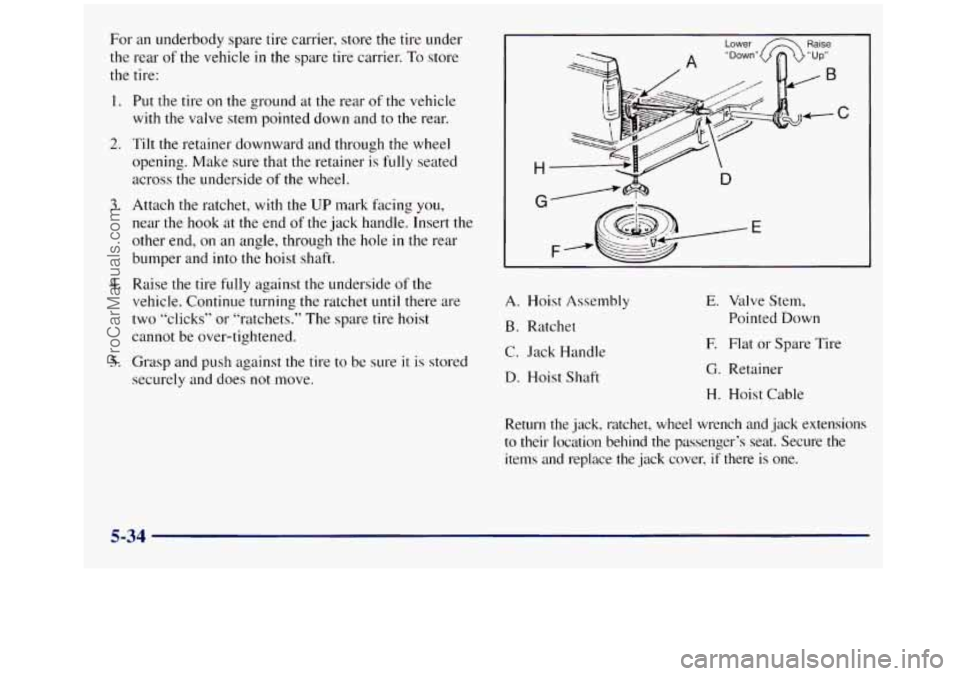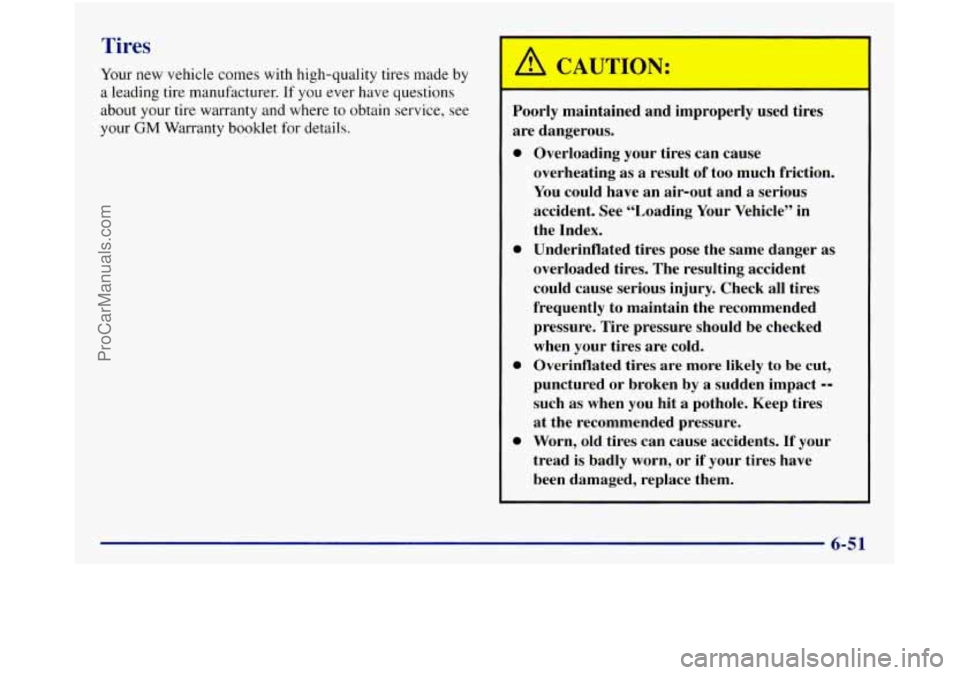Page 276 of 452

Changing a Flat Tire
If a tire goes flat, avoid further tire and wheel damage
by driving slowly to a level place. Turn on your hazard
warning flashers.
Changing a tire can cause an injury. The vehicle
can slip off the jack and roll over you or other
people. You and they could be badly injured.
Find
a level place to change your tire. To help
prevent the vehicle from moving:
1. Set the parking brake firmly.
2. Put an automatic transmission shift
lever in PARK
(P) or shift a manual
transmission to FIRST
(1) or
REVERSE (R).
3. If you have a four-wheel-drive vehicle,
be sure the transfer case is in a drive
gear
-- not in NEUTRAL (N).
4. nrn off the engine.
CAUTION: (Continued)
To be even more certain the vehicle won’t move,
you can put blocks
at the front and rear of the
tire farthest away from the one being changed.
That would be the tire on the other side of the
vehicle.
at the opposite end.
V
The following steps will tell you how to use the jack and
change a tire.
ProCarManuals.com
Page 278 of 452
A. Hoist Assembly
€3. Ratchet
C. Jack Handle
D. Hoist Shaft
E. Valve Stem,
Pointed Down
E Spare Tire
G. Retainer
H. Hoist Cable Follow
these instructions to lower the spare tire:
1.
2.
3.
4.
One side of the ratchet has an UP marking. The other
side has
a DOWN marking. Assemble the ratchet to
the hook near the end
of the jack handle (as
illustrated) with the DOWN marking facing you.
Insert the other end through the hole in the rear
bumper and into the hoist shaft.
Turn the ratchet to lower the spare tire to the ground.
Continue to turn the ratchet until the spare tire can be
pulled out from under the vehicle.
When the tire has been lowered, tilt the retainer at
the end
of the cable so it can be pulled up through
the wheel opening.
Put the spare tire near the flat tire.
5-26 I
h
ProCarManuals.com
Page 279 of 452
The tools you’ll be using include the jack (A), the jack
handle extension
(B), the jack handle (C), the wheel
wrench
(D) and the ratchet (E).
If the flat tire is on the rear of the vehicle, you’ll need
the
jack handle extension also.
Attach thejack handle (and jack handle extension, if
needed) to the jack.
ProCarManuals.com
Page 281 of 452

Removing the Flat Tire and Installing the
Spare Tire
1. Use the ratchet and
wheel wrench to loosen
all the wheel nuts. Turn
the wheel wrench to the
left, with
DOWN facing
you,
to loosen the wheel
nuts. Don't remove the
wheel nuts yet.
Front Rear
Position Position
2. Position the jack under the vehicle. If the flat tire is
on the front of the vehicle, position the jack on the
frame behind the flat tire.
If the flat tire is on the
rear, position the jack on the rear axle between the
spring and
the shock absorber.
Getting under a vehicle when it is jacked up
is
dangerous. If the vehicle slips off the jack, you
could be badly injured or killed. Never get under
a vehicle when it is supported only by a jack.
/i CAUTIOL.
-
Raising your vehicle with the jack improperly
positioned can damage the vehicle and even make
the vehicle fall.
To help avoid personal injury and
vehicle damage, be sure to fit the .jack lift head into
the proper location before raising the vehicle.
5 - :
ProCarManuals.com
Page 282 of 452
Front Position Rear Position
3. With UP on the ratchet fixing you, raise the vehicle
by rotating the ratchet and wheel wrench to the right.
Raise the vehicle far enough off the ground
so there
is enough room for the spare tire to fit.
4. Remove all the wheel
nuts and take
off the
flat tire.
- --__.
I I
5. Remove any rust or dirt
from the wheel bolts,
mounting surfxes and
spare
w hee I.
5-30
ProCarManuals.com
Page 285 of 452
NOTICE:
Improperly tightened wheel nuts can lead to
brake pulsation and rotor damage.
To avoid
expensive brake repairs, evenly tighten the wheel
nuts in the proper sequence and to the proper
torque specification.
9. Put the wheel trim back on. For vehicles with plastic
wheel
nut caps, tighten the caps until they are
finger-tight, then tighten them an additional one-half
of a turn with the ratchet and wheel wrench.
Storing a Flat or Spare Tire and Tools
A CAUTION:
Storing a jack, a tire or other equipment in the
passenger compartment
of the vehicle could
cause injury. In
a sudden stop or collision, loose
equipment could strike someone. Store
all these
in the proper place.
Store the flat tire where the spare tire was stored.
5-33
ProCarManuals.com
Page 286 of 452

For an underbody spare tire carrier, store the tire under
the rear
of the vehicle in the spare tire carrier. To store
the tire:
1.
2.
3.
4.
5.
Put the tire on the ground at the rear of the vehicle
with the valve stem pointed down and to the rear.
Tilt the retainer downward and through the wheel
opening. Make sure that the retainer
is fully seated
across the underside
of the wheel.
Attach the ratchet, with the
UP mark facing you,
near the hook at the end
of the jack handle. Insert the
other end, on an angle, through
the hole in the rear
bumper and into the hoist shaft.
Raise the tire fully against
the underside of the
vehicle. Continue turning
the ratchet until there. are
two “clicks” or “ratchets.” The spare tire hoist
cannot be over-tightened.
Grasp and push against the tire to be sure
it is stored
securely and does not move.
I Lower Raise
A. Hoist Assembly
B. Ratchet
C. Jack Handle
D. Hoist Shaft
E. Valve Stern,
Pointed Down
E Flat or Spare Tire
G. Retainer
H. Hoist Cable
Return the jack, ratchet, wheel wrench
and jack extensions
to their location behind the passenger’s seat. Secure the
items and replace the jack cover,
if there is one.
5-34
ProCarManuals.com
Page 341 of 452

Tires
Your new vehicle comes with high-quality tires made by
a leading tire manufacturer.
If you ever have questions
about your tire warranty and where to obtain service, see
your
GM Warranty booklet for details.
A CAUTION:
Poorly maintained and improperly used tires
are dangerous.
0
0
0
0
Overloading your tires can cause
overheating as
a result of too much friction.
You could have an air-out and
a serious
accident. See “Loading Your Vehicle” in
the Index. Underinflated tires pose the same danger as
overloaded tires. The resulting accident could cause serious injury. Check all tires
frequently to maintain the recommended
pressure. Tire pressure should be checked when your tires are cold.
Overinflated tires are more likely to be cut,
punctured
or broken by a sudden impact --
such as when you hit a pothole. Keep tires
at the recommended pressure.
Worn, old tires can cause accidents. If your
tread is badly worn, or if your tires have
been damaged, replace them.
6-51
ProCarManuals.com